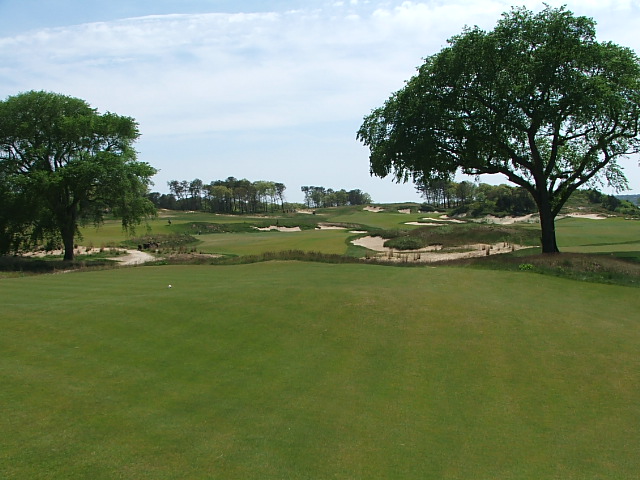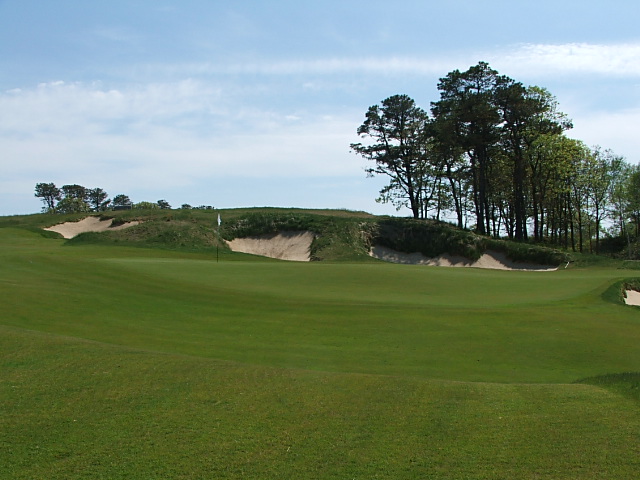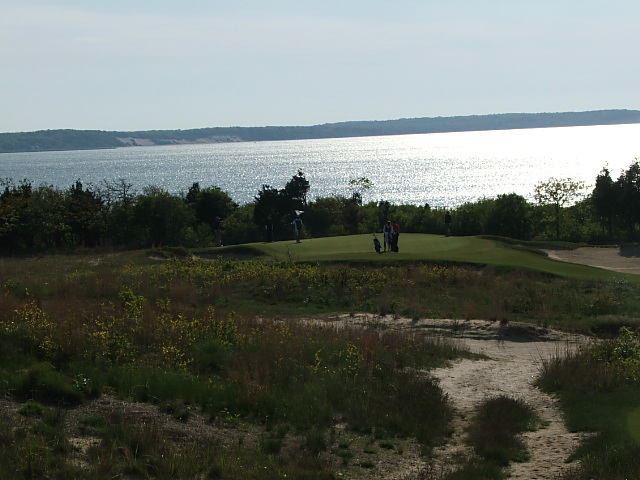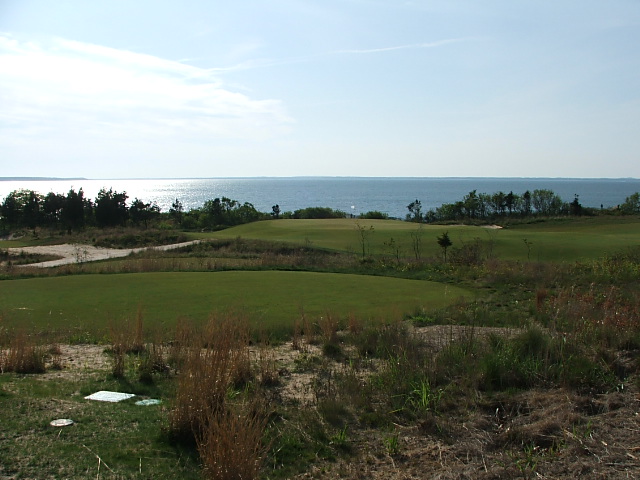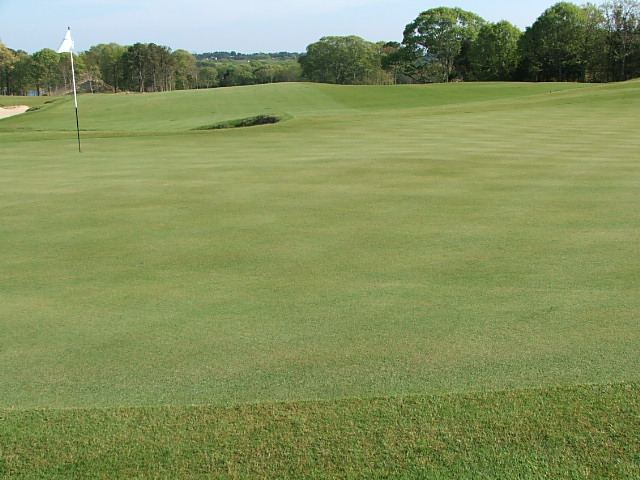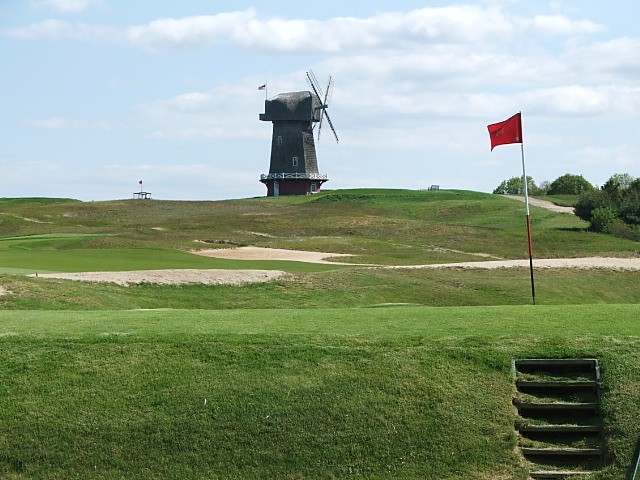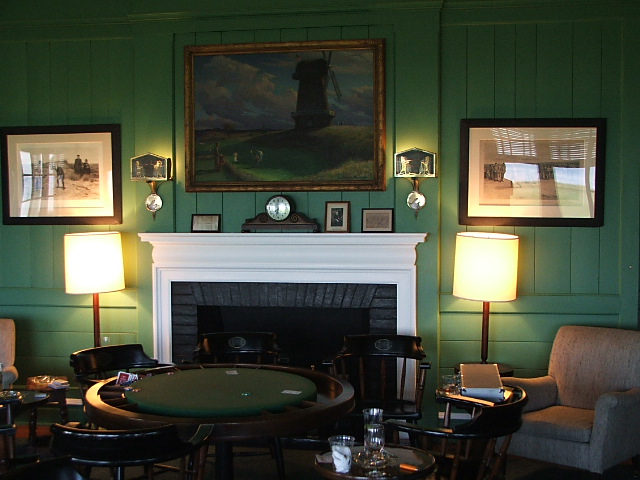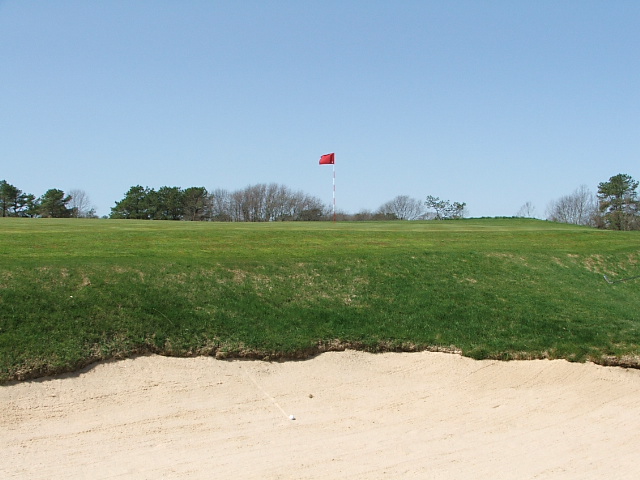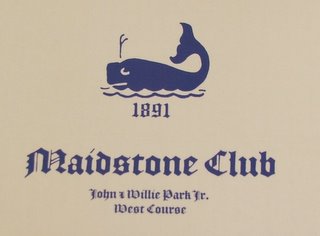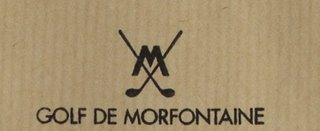
The stakes are high when you are building a new course next to two of the world's greatest courses. Sebonack Golf Club is located next to both the National Golf Links of America and Shinnecock Hills in Southampton, NY. Sebonack is located nearer to Peconic Bay than Shinnecock, immediately to the west of The National.
Sebonack is an old native American Indian word that roughly translates into "golf club for the filthy rich." The Indians were very prescient in their naming of this land, which seems like it was always destined to be a golf course. It has the perfect sandy soil for golf with gorgeous views overlooking the bay. Similar to the benevolent dictator model that was the genius behind The National (Macdonald), Oakmont (Fownes) and Pine Valley (Crump), so it is with Sebonack and Mike Pascucci. Pascucci made his money in the car leasing business. He reportedly paid $46 million for the 300 acre property. It is also reported that the course and the club cost between $100 and $120 million to build all-in, plus or minus a couple of million, but whose counting among friends?
The price of entry into Sebonack is a tad high. There is a $650,000 initiation fee and membership is by invitation only. Similar to The National Golf Links, Sebonack has "founding" members. These ten gentleman shelled out $1 million each for the privilege and can nominate and sponsor new members. The total net-worth of the ten founders combined exceeds the gross domestic product of many countries. Sebonack will probably be the first golf club not only ranked in the top 100 golf courses in the world, but also as a stand-alone entity will rank in the World Bank top 100 GDP rankings. If it were a sovereign state, it would rank between Mozambique and Estonia.
I have been getting feedback from my readers accusing me of being a golf snob. I can assure you my dear fans, that nothing is further from the truth. I learned to play the game playing on municipal courses, waiting for long stretches on tee boxes and without any of the perks and thrills that these elite courses offer. I can also assure you that I could not join Sebonack even if I was invited to, which I have not been. I have perfected the art of networking and have an unflappable determination to play all the world's top courses; in many cases, simply by asking the right people. I may be a pompous charlatan, but I am not a snob.

Pascucci hired the unlikely team of Jack Nicklaus and Tom Doak, who have very different styles, to design Sebonack. The idea was that Doak would do the major routing and be responsible for the look of the course, while Jack would help on the risk/reward decisions and design. Who knows what the real truth is or what the dynamics of the two partners were when designing and building the course? Rumor has it that it was a tense relationship. If the rumor is true, then tension produces a good golf course. Now that this beauty of a course is in place, it hardly matters how they got along; the course is spectacular. The bunkers on most holes were clearly influenced by Doak; it has the same look and feel as many holes on Pacific Dunes. I personally saw the Nicklaus influence on the par threes, particularly the fourth and eighth holes.
Although I haven't read anywhere that Doak or Nicklaus set out to replicate holes from other courses at Sebonack, I found that, similar to what Macdonald did at The National, many holes here are strong replicas of other classic holes from around the world.
The exciting opening hole at Sebonack
Sebonack is a golf course that both lives up to the potential of this unique site and the pedigree of its designers. Although it is a new course, having opened in 2006, I believe it instantly has one of the best starts in golf; rivaling Merion and Prestwick with opening holes that get the juices flowing. Like these two grande dames, the first hole at Sebonack is a very short par four, at 337 yards. Like at Merion, it is a dog-leg right and it is set so that as you walk toward the green, the bay starts to become visible in front of you. I personally like a short starting hole, which gives the opportunity to start your round with a birdie or par. Don't be fooled by the short yardage on the card into thinking it is a complete lay-up hole, however. The real fun starts when you take out the flat stick. The first green is wild and crazy with wicked undulations. Walking up to putt on the first green is like getting hit in the face with a wet dish rag. It hurts. Never-the-less, the green shocks you into the round and unmistakeably lets you know that you are in for a unique round of golf.
The second hole is the best on the course in my view, and one of the best in the world. It is the number one handicap hole and plays 414 yards with an uphill second shot. The prevailing wind is in your face, so it plays longer than the card. You have to hit your tee shot through two large American elms that frame the fairway about 100 yards off the tee box. The shot plays down a hill into a valley that is covered with sand and bunkers. It requires a well struck ball to find the middle of the fairway, but the hole has classic risk-reward characteristics that rewards a well played shot hit between the bunkers with a favorable kick forward. The second hole reminded me of a combination of the 12th at Prairie Dunes, with the two trees serving as sentinels on either side of the fairway; and the 8th at Crystal Downs, with the severely sloping green that repels a short shot.
The second hole seen from the tee box - world class
This second shot into the green is an instant classic in the golf world, although I can see how it may be controversial. Some may call the green unfair because the foreword one-third of it is such a severe drop-off. I can't even imagine how they mow the grass. A shot hit too far goes into the devilish downhill bunker beyond the green. If you hit your shot to the right spot on the green past the drop-off, but short of the bunker, it is a rewarding shot because the ball feeds down to the center of the green. Because of the steep drop-off, this is effectively a postage-stamp green. The margin for error is almost nil. It is difficult to see the severity of the drop-off coming into this green from the photograph (below). The green is elevated probably eight-to-ten feet above the fairway, so severe is not too strong a word to describe it.
Approach to the second hole
As if the second hole wasn't great enough, what also makes it more interesting is the history behind the trees. This property at one time was the summer estate of Charles H. Sabin, former president of The Guaranty Trust Company. Sabin was an original founding member of The National Golf Links of America and a friend of Charles Blair Macdonald. The trees used to be on either side of his manor house ("Bayberry Land"), which was taken down when the course was built. The entrance gates you drive through to get into Sebonack (picture of the gates is at the top of this post) are also from the original Sabin estate.
The fifth hole is noteworthy as a short, down-hill par four with great risk-reward characteristics. It reminds me of the world-class seventeenth at The National. According to our host, this was a hole Nicklaus was responsible for and Jack feels it is similar to the 12th hole at The Old Course at St. Andrews. The hole is only 360 yards and plays downhill, with a pot bunker in the middle of the fairway, so you have to choose to either lay-up or go left or right and are duly penalized or rewarded.
The par three 12th green
The par three twelfth hole (above) reminds me of the 14th hole at nearby Maidstone, which I like. It is a 136 yard par three that plays down into sand dunes with the bay as the back-drop. Nicklaus says this hole is modeled after the Postage Stamp hole at Royal Troon, but I don't see any likeness.
The 11th green
The routing at Seconack is interesting. The whole property gently slopes downhill toward the bay. The first three holes play near the water, then the character of the course changes as you go in-land into a forested area. Several holes are then in a sandy/scrubby area. Once you get back to the green at the eleventh hole you are back near the water for two holes, then the course goes back in-land. There is a great vista that unfolds before you when you are finished playing the 17th hole. You walk through a clearing out onto a high bluff overlooking Peconic bay. The 18th plays immediately next to the bay on your left the entire way home.
Approach to the 16th green - notice the "Doak" influence on the bunkers
The course is set on prime Hamptons real estate in an idyllic setting that helps you to sometimes forget where you are as you snake around the course. In a lovely surprise, as we were walking to the ninth tee, a group finishing the 'Alps' hole at the adjacent National Golf Links rang the bell as they were walking off this blind green to signal to the group behind them that they were done playing the hole. The 'Alps' hole is as close a 50 yards from you as you tee off on this uphill par five. It is very charming.
I wouldn't say all 18 holes at Sebonack are standouts. The par three fourth is nothing special. The eighth and thirteenth holes are also not standouts and the water carries over the in-land ponds seem a bit forced to me. The greens were a little slow when we played which is chalked up to the course being new, although they were in excellent condition. The course plays pretty difficult so I imagine when the greens fully grow in and are fast, it will be a stern test of golf, especially when the wind is up. I also liked several of the green complexes, like the third hole, that allow you to hit shots into the back of the greens and slope back down to the center - serving as a backstop effect. Particularly on uphill shots this allows you to be aggressive on a well-struck approach shot. To me, this was one of the defining characteristics of the course.
The ninth green
As it turns out, the match I was playing ended up tied on the 18th green so we played the 'bye' hole, or 19th hole. The 19th hole is a short par three near the 18th green that plays back toward the bay. The idea of this extra hole is exactly what we used it for, which is as a tie-breaker for matches. The genius of it is that it's a short hole. I hit an eight iron, as did my playing partner. It's very exciting to both have birdie chances to win a playoff. Well done Jack and Tom!
The down-hill 11th hole from the tee box
I enjoyed playing Sebonack a lot. Although the course is too new to be ranked yet, my sense is it will soon become recognized as one of the world's top courses. I had a dream day of golf when I played Sebonack. I played The National Golf Links in the morning, had their famous lobster lunch, followed by an afternoon round at Sebonack. Thanks to my Ecco shoes, two great caddies and lots of adrenaline, I happily played the 37 holes and was not fatigued in the least as the sun started to go down. I don't want to rub it in, but I am living la dolce vita in my golf travels, although all the lobster and walking caused both my gout and my lumbago to flare up. Occupational hazards.
When I grow up, I want to retire to the Hamptons and have my choice of playing Shinnecock Hills, Maidstone, The National and Sebonack. There are no finer collection of courses located so close to each other anywhere in the world.
It almost feels like you are back in the roaring 20s on the eastern end of Long Island these days. We are fortunate to live in a second "Golden Age" of golf course architecture fueled by rampant economic prosperity globally. The Sabin's were one of the most prosperous families of the Jazz Age and spent time during the summers entertaining at their Southampton home. It is hard not to feel just a bit like Gatsby while at Sebonack.
Modern Day Golf Course Development
In an interesting case study of golf course development today, I stumbled across the public relations strategy many new courses engage in. I always research all the courses I play and try to read as much as possible about them. For Sebonack, I read about fifteen magazine and newspaper articles about the course. I found it funny that they almost always use the same canned phrases, stock photos and quotes. My research revealed that Sebonack uses the Hunter Public Relations firm to spin its story. Coincidentally, it appears to be the same firm that markets Trump courses as well. It is pretty sad to me how the media basically just reprints press releases and works with P.R. firms to do stories and prints canned quotes. How about some original reporting and thoughtful commentary? How about getting out there and getting some sand in your shoes and eating some lobster?
Part of the reason I write this blog is to give an undiluted opinion and behind the scenes look without the fear of pissing off a course or a potential advertiser. I am the editorial board, the legal department and the in-house fact checker. I like my independence. That, plus, I have never even remotely been offered a writing job; but let's not quibble over a small point.
The "cottages" under construction at Sebonack
I suppose it makes sense for a course like Sebonack to market itself from a P.R. standpoint. It certainly helps eliminate the perception that this is a playground for the über wealthy; it helps to "position" the story of development in an environmentally friendly way; and it no doubt helped Jack and Tom stay on the same page publicly.
Mike Pascucci is described in all the press accounts as a local guy made good and is very philanthropically oriented. Based on my own research, and unlike the horses-ass-of-the-world Trump, the P.R. here does not distort. I know two people who know Mike, are unaware of my secret identity, and without solicitation both confirmed that he is the genuine article. He's the anti-Trump. I commend him for living his dream and building Sebonack. The course lives up to everything I have seen written about it.
The "cottages" and clubhouse are still being constructed at Sebonack. For the Hamptons, the "cottages" are relatively modest - each will hold a fore-some. They reminded me of the cottages at Bandon Dunes and Sand Hills. The clubhouse is being built at the highest point on the property and will have majestic views looking down on the National clubhouse, Peconic bay and the course. From the look of the skeleton of the building that was present when I was there, it does not look like it will be a modest building. It looks like, when complete, it will be the Parthenon of the golf world and will shortly assume an exaulted place in the world of golf that obesssive golfers such as myself will clamor to be invited to.
The interesting history of the Sabin estate "Bayberry Land"

